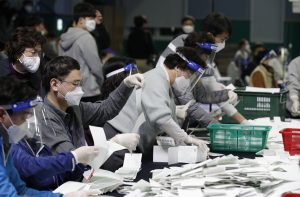In elections held in South Korea last week, the ruling liberal Democratic Party and its satellite Citizen Party won 180 seats of the 300 seats in the National Assembly. The conservative opposition United Future Party and its satellite Future Korea Party were meanwhile left with just 103 seats.
The resounding win frees the government from the limitations of the National Assembly Advancement Act, so that it is now able to legislate anything other than constitutional amendments. This was a historic election, even more so when taking into consideration that it took place under the extraordinary circumstances of the COVID-19 pandemic.
Some observers have argued that South Korean politics might be transitioning from a conservative/liberal two-party system to a liberal-predominant party system, like the conservative LDP-predominant party system that existed in Japan during the Cold War. However, if we look at voter turnout for candidates in single-seat constituencies, it was 49.9 percent for the liberal ruling party and 41.5 percent for the conservative opposition party, hardly a crushing difference. Moreover, in proportional representation constituencies, the other conservative opposition party actually finished first with 33.8 percent, leading the other liberal with 33.4 percent, a low figure even when accounting for the split in the liberal group.
Given these numbers, it is premature to conclude that we are at the start of an era dominated by a single party. Indeed, it is worth remembering that conservative votes accounted for more than 60 percent of the results in the 2007 presidential election 13 years ago, giving the conservatives a landslide win over their liberal opponents, despite a split between the conservative candidates, and bringing about a change of government.
The election this time was meant to have been a mid-term evaluation of the accomplishments of the Moon Jae-in Administration over the past three years. As far as the South Korean economy goes, the “income-led growth strategy” was unfortunately not sustainable, so it would be difficult for the government to make claims about economic growth or reducing unemployment. As for its North Korea policy, with the linking of the North–South summit and the U.S.–North Korea summit in 2018, Moon did make some progress in terms of peacebuilding on the Korean peninsula through North Korean denuclearization. However, not only did this progress stall in 2019, there have been concerns that tensions might be rising anew.
Given this assessment, pundits initially felt that the ruling party might struggle in this election. Yet the government won in a landslide, armed with both its firm base of supporters, who account for around 40 percent of the electorate, and the widespread praise it has earned for its response to the COVID-19 pandemic. That response has been extremely “aggressive,” with comprehensive testing and contact tracing combined with a strict isolation policy. As a consequence, South Korea is now being hailed both domestically and around the world as a success story, with just a few new cases being reported each day.
That presents a very sharp contrast to the “defensive” posture adopted by Japan, which has strictly limited coronavirus testing on fears that its healthcare system could collapse. To date, one could argue that the social costs of South Korea’s policy have been greater than those of Japan’s, and it is certainly too early to declare South Korea a success story and Japan a failure.
Nonetheless, the majority of South Korean voters, with the exception of older conservative voters in Gyeongsang Province, have been moved to place their hopes in the Moon Jae-in Administration, which now faces the tasks of restoring severed supply chains and turning around an economy that has been hard hit by COVID-19. Given its record to date, whether the administration has the ability to do that is an open question.
One thing that is not in question is the need to mend relations with Japan. Certainly, supply chains with Japan have not been completely severed, but bilateral tensions will undoubtedly increase if the South Korean government goes ahead with measures to convert the assets of Japanese companies in South Korea into cash on the basis of conscripted workers rulings. These tensions will hardly be conducive to a South Korean economic recovery.
For its part, if it wants to minimize the social costs of the current pandemic Japan needs to use its latecomer advantage and learn from South Korea’s experience. And both countries should recognize that it is precisely because they currently face the same challenge of overcoming COVID-19 that they must act to reduce the tensions that have hamstrung the relationship.
Tadashi Kimiya is a professor at the University of Tokyo.
































